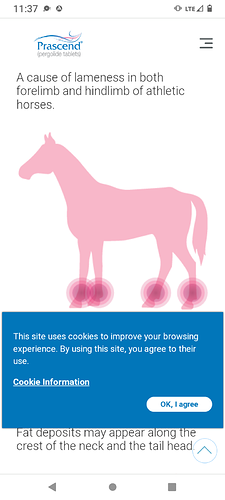My mare was recently diagnosed with suspensory branch desmitis in both hind legs. She blocked to her RH suspensory & her LH fetlock but we didn’t see anything abnormal on ultrasound of the entire suspensory of both hind legs. So we went to MRI and here are the MRI results:
Right hind: The suspensory ligament branches have multifocal mild to moderate fiber abnormalities. The lateral suspensory ligament branch is moderately enlarged and misshapen. The medial suspensory ligament branch is mildly enlarged with focal axial fiber disruption at the sesamoid bone insertion (3 to 4 mm in diameter). Focal central sclerosis with the possibility of mild fluid is present in the distal diaphysis of the third metatarsal bone with additional, mild to moderate sclerosis in the distal aspect of the bone.
Left hind: Multifocal mild to moderate fiber abnormalities are present in the suspensory ligament branches. In addition, the lateral suspensory ligament branch is enlarged with mild to moderate periligamentous tissue proliferation. The lateral suspensory branch enlargement continues to the level of the bifurcation with lateral enlargement of the distal suspensory ligament body. The third metatarsal bone has moderate fluid at the dorsal aspect of the sagittal ridge and mild to moderate distal condylar and sagittal ridge sclerosis.
So I asked my vet to put the above in non-vet terms for me LOL She said essentially it’s mild inflammation throughout the ligaments - no lesions were found, just all over inflammation and changes.
The bad news is that this all started at the end of last July and was not able to be diagnosed until earlier this month (April). Unfortunately the prior vets who were treating my mare suspected the lameness was coming from her hips or SI - we injected the SI and the lameness resolved so we slowly started her back into work. For 2 months it was going well, and 3 weeks into adding trot work back in, the lameness returned. That is when we got a 3rd vet involved who has the lameness locator, and that’s when the suspensory diagnosis was made. So I am sure that the under saddle work, albeit low level, contributed to the damage we found on MRI.
So at this point, I am trying to figure out what the prognosis looks like, which is hard since I know it varies wildly from horse to horse. My mare is 23 and for the past 6 years has just been my casual low level (Training level) Dressage horse. Prior to that she was my low level Eventer (BN level). She has never been lame in the 16 yrs I have owned her, until this. She’s actually in VERY good shape for her age! (Here are some recent photos of her) But I know that branch injuries are tough to rehab and I want to make sure I do this right! We’ve done shockwave and she is on anti-inflammatories. She has always been successfully barefoot, but we just put hind suspensory shoes on her. We’ve been doing nothing but handwalking + some stretches since the diagnosis was made.
The vet who did the MRI told me that once we can get her to about a 75-80% comfort level (she’s at about 60% now on 2g Bute/day…and I measure it based on the % of time she spends standing on both hinds vs. resting RH or LH), that we can start adding in some light walk under saddle. But everything I keep reading suggests that they have to be on stall rest for MONTHS before you even think about doing that! So should I be taking this much slower?
She is still on her usual overnight turnout, only because she has always been a LAZY laid back girl and she goes out in her own half-acre paddock, doesn’t run or really do anything except meander around and eat, so all 3 vets thought it would be better to have her out and moving around since she’s unlikely to do anything stupid in turnout to worsen her situation.
I am curious to know what others’ rehab plans were for an injury like this - and if you’ve read this whole post, THANK YOU and congrats! haha

 .
.

